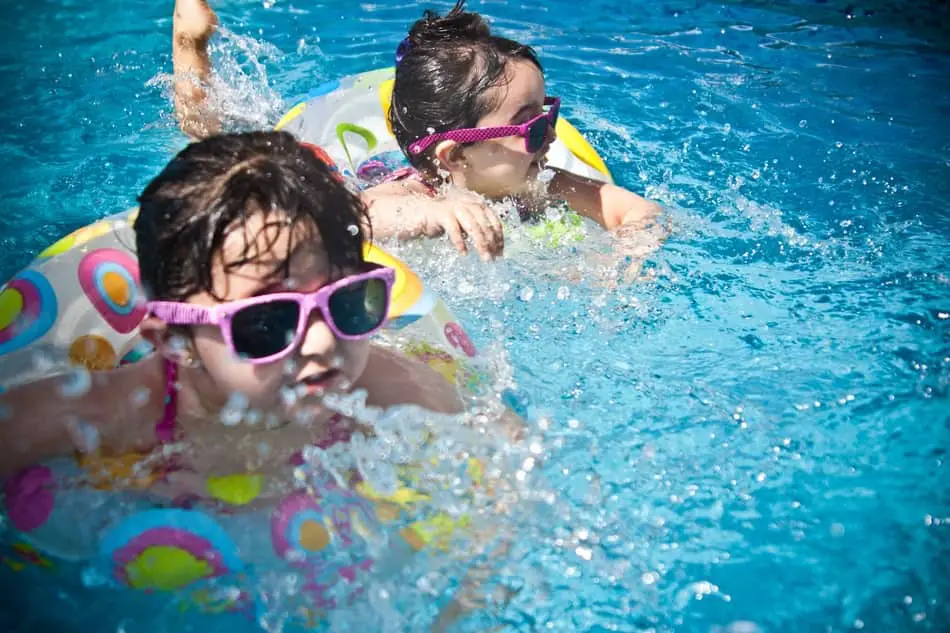Each year, billions of chlorine are produced in the United States so it’s a very common chemical that cuts across most industries. The most common application of chlorine is in pharmaceutical products, plastics, cleaning products, and most commonly swimming pools to help purify the water and kill germs.
With such a high level of wide usage, it’s no surprise chlorine will from time to time find its way onto leather goods – with the most common culprit being chlorine from pool water and leather car seats and furniture as the most likely victims.
So is chlorine bad for leather? Depending on the level of concentration and how pure it is chlorine can be very detrimental to both the overall look and structure of leather. Chlorine when it comes into contact with leather can remove all of the leather’s essential oils and cause the leather to become brittle, dried up, and eventually lead to dry rot.
From my research, I found out 5 additional reasons why chlorine is bad for leather. To learn more about the details of the possible negative impacts of chlorine on your leather items, keep reading this article.
1. Chlorine Makes Leather Brittle
Chlorine can make leather brittle and quite hard when it find its on it. Let me tell you a little story.
I decided to write this article over the weekend because of something that happened to my car leather seats about a week ago.
My son often has his swimming lessons every Saturday and we normally go on foot while enjoying our usual chit-chat (He’s 3 by the way!).
Over this weekend, my 3 lovely nieces visited while their parents were away for a funeral for the entire weekend.
Just so the kids do not become bored staying at home all weekend, I decided to take all 4 kids to my son’s swimming practice. I decided to take my car since it was such a fullhouse that day.
They had such a great time swimming in the pool which I later realized had too much chlorine. The next morning I got back to my car and saw the wet swimsuit of the kids got the leather wet.
What’s even worse is that it had dried and turned brittle on the seat where the kids sat – All four seats excluding the driver’s seat where I sat.
2. Chlorine Can Remove Finish From The Leather Surface
Another reason why chlorine is bad for leather is that it removes the finish on the surface of the leather. This will generally include dyes, polishes, and even the beautiful patina the leather might have developed over a period.
This is because chlorine works somewhat like bleach depending on how pure it is. More often than not chlorine will be able to strip out any color or polish that has been put on the leather.
After my leather car seats became brittle, I went about researching and I found out a lot of the damages chlorine could have on leather items.
Although in my case I did not have such any significant color loss, I found a ton of people who had this happen to them and hitherto found no remedy.
Not only can this happen to leather but chlorine can also remove any sort of dyes and other colorants from fabrics.
If the surface of your leather item is not heavily coated or protected, then chlorine will almost immediately change the color of the leather once the leather has had contact with it.
Again, all this will depend on how pure or the level of chlorine concentration.
Related Article: 3 Best Leather Cleaners And Conditioners For Matte Finish
3. Chlorine Will Age Leather
Chlorine is also bad for leather because it can seriously age your leather once it gets into contact with it.
Your leather item may be new-looking one moment but once chlorine gets on it the leather will begin to show signs of hard use, wear and tear.
Although leather on its own will eventually age in terms of its color and the type of wear that occurs on its surface with time – generally called patina, chloride is going to speed up the process of leather aging and patina process.
This will also depend on how pure the chlorine is as I have said over and over again. If you’re dealing with a high concentration of chlorine getting onto leather then you could have your leather looking all dried out, cracked up, and pale looking.
This is by no means fun as you would want to enjoy the original look of your leather items many many years before it begins to show any signs of aging.
Related Article: 6 Ways Patent Leather Age Plus How To Slow The Aging
4. Chlorine Can Dry Out And Crack Leather
Leather is a very durable material but it’s also a have absorbent material due to how porous it is.
While the quality of porosity allows leather to be such an outstanding material with breathing qualities, it also allows liquids, scents, and other forms of substances to easily get absorbed into the leather.
Even though your leather item may have been marketed as coated, leather would always retain some level of porosity.
Another dynamic to the leather structure is that it contains fibers that hold moisture and essential oils that help to prevent the leather from drying out and also allows the leather to remain flexible and supple.
When chlorine gets onto your leather, it’s going to quickly get absorbed into the fibers of the leather and then the damage begins.
Basically, what the chlorine is going to do is to leach out the essential oils that help to nourish the leather. When this happens, the leather begins to dry, and once dry the leather will start to crack and peel.
Related Article: 5 Effective Ways To Prevent Patent Leather From Cracking
5. Chlorine Can Cause Leather To Dry Rot
As mentioned before leather is a robust material but needs a little bit of tender loving care to ensure it lasts life long.
This means leather needs to be properly cared for from time to time to to avoid severe damages.
Chlorine simply takes such a huge toll on leather that has no form of protection or surface treatment – not only on the surface but also on the overall structure.
By now it’s clear from the previous point that chlorine can rob leather of its essential oils and cause the leather dry out and crack.
Chlorine can also cause further damage if the leather is not treated on time. The chlorine damage can lead to dry rot on the leather.
Dry rot results after the essential oils of the leather have been lost and the fibers of the leather have not only dried out but also begun to pull apart and subsequently causing the entire leather to weaken and break.
6. Chlorine Can Cause Leather To Stink
Everyone knows the soothing scent lovely smell of real natural leather. Leather inherits its beautiful smell from its tanning agents or its fats and oils.
Although leather is tanned differently, it will always come with smells that are incomparable especially vegetable-tanned leather.
Having said that, there are several things that can cause the natural luxurious smell of leather to be replaced by foul odoriferous smells.
Something as simple as water can cause leather to stink. The way this will typically happen is when leather becomes damp from water and not properly allowed to dry, this can cause the leather to develop mold that eventually cause leather to stink.
So throw water concentrated with chlorine into the mix and your leather will reek.
Chlorine is a common element used in most industries and can also be found in a lot of household products. Chlorine will usually be recognized by its irritating odor similar to the odor of you will often have with bleach.
A classic example of how leather can reek from chlorine is with swimming pools.
This is when chemical compounds consisting of chlorine disinfectants combine with body oils, urine, perspiration on the bodies of swimmers enter the pool – and subsequently finds their way onto the leather can cause the leather to stink.
Related Article: 7 Very Simple Ways To Get Smells Out Of Leather Car Seats
Tips On How To Identify, Prevent, & Fix Chlorine Damage On Leather
- You would probably want to clean the chlorine stain from your leather using a good leather cleaner and then following up with conditioning using a leather conditioner. This will particularly help to soften the leather if the leather has become brittle from the chlorine.
- You also want to clean and condition the leather as immediately as possible when the chlorine gets into contact with the leather.
- Given the endless and severity of the damage, chlorine can do to leather it’s such a no-brainer that you would want to ensure your leather seats are covered before your throw yourself on them if you’ve been swimming in a pool.
- You can also ensure you dry your body very thoroughly with a towel after getting out of the swimming pool. Better still, you can take a quick bath if the recreational center has a locker room.
- You want to treat your leather with leather conditioners and protectors from time to time so that it remains protected from any sort of damage from chlorine or other harmful substances that the leather may come into contact with.
- Dry rot is one of the common end-games to what chlorine can do to leather. So in light of this here are a couple of tips to help prevent this severe and irreparable damage.
- The first thing is to observe the color of the leather. Any leather item that has begun to dry rot will often look lighter in color and somewhat grayish.
- You can do a simple test to find out by dampening a small section of the leather with ordinary water. If the water damp areas of the leather turn or appear significantly darker than the dry areas, then the leather item may be affected by dry rot.
- Another way to find out if your leather has been severely affected by chlorine to the point of dry rot is by feeling the leather surface. If you find the surface of the leather to be brittle or hard to touch then it’s very possible dry rot has begun.
- Another way is to find out if there are any powdery deposits on the surface of the leather after it has come into contact with the chlorine. From observation, if you find any powdery substance after touching the leather surface then your leather may likely be dry rotted.
The last and most obvious way is to take a closer look at the textures on the leather. If there are seemingly obvious cracks or tears on the leather surface after it has been exposed to chlorine then dry rot may be present.


